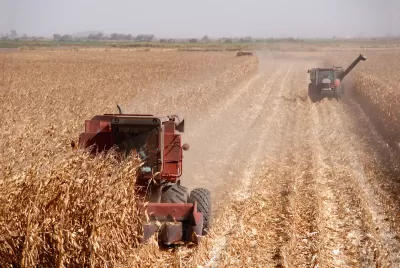The San Joaquin Valley has some of the worst air pollution and particulate matter emissions in the nation, but agricultural sources are loosely regulated.

California’s most intensively farmed counties don’t pass the EPA’s newest standards for particulate matter, reports Virginia Gewin in Civil Eats. Some are not even close to reaching the prior target established in 2012. “Agriculture’s contribution to PM2.5 stems from burning, soil management, and gaseous emissions from both tractors and soil,” Gewin explains.
“The San Joaquin Valley is the largest agricultural producing area in the nation; it produced crops, livestock, and agricultural commodities worth $36.5 billion in 2022. The southern half of California’s 450-mile Central Valley is also home to some of the worst annual air pollution in the nation. Mountain ranges trap emissions from highway traffic, locomotives, municipal composting facilities, tractors, and burning.”
The article details steps the district is taking to reduce emissions and improve air quality in the regions, but critics say the regulations don’t go far enough in the agricultural sector. For example, agricultural tractors are not regulated by CARB, despite being a major source of emissions. Meanwhile, water restrictions will force farmers to leave hundreds of thousands of acres of farmland fallow, which could generate more dust.
FULL STORY: California Farm Counties Are Not Even Close to Meeting the EPA’s New Clean Air Quality Standard

Maui's Vacation Rental Debate Turns Ugly
Verbal attacks, misinformation campaigns and fistfights plague a high-stakes debate to convert thousands of vacation rentals into long-term housing.

Planetizen Federal Action Tracker
A weekly monitor of how Trump’s orders and actions are impacting planners and planning in America.

San Francisco Suspends Traffic Calming Amidst Record Deaths
Citing “a challenging fiscal landscape,” the city will cease the program on the heels of 42 traffic deaths, including 24 pedestrians.

Defunct Pittsburgh Power Plant to Become Residential Tower
A decommissioned steam heat plant will be redeveloped into almost 100 affordable housing units.

Trump Prompts Restructuring of Transportation Research Board in “Unprecedented Overreach”
The TRB has eliminated more than half of its committees including those focused on climate, equity, and cities.

Amtrak Rolls Out New Orleans to Alabama “Mardi Gras” Train
The new service will operate morning and evening departures between Mobile and New Orleans.
Urban Design for Planners 1: Software Tools
This six-course series explores essential urban design concepts using open source software and equips planners with the tools they need to participate fully in the urban design process.
Planning for Universal Design
Learn the tools for implementing Universal Design in planning regulations.
Heyer Gruel & Associates PA
JM Goldson LLC
Custer County Colorado
City of Camden Redevelopment Agency
City of Astoria
Transportation Research & Education Center (TREC) at Portland State University
Jefferson Parish Government
Camden Redevelopment Agency
City of Claremont



























